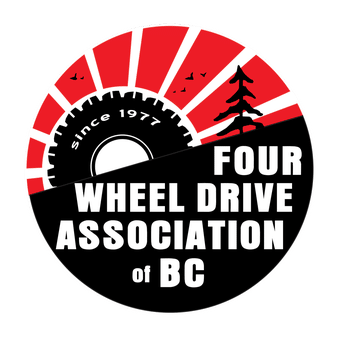WHAT YOU NEED TO KNOW
BACKCOUNTRY COMMUNICATIONS
Let’s talk about staying in contact in the backcountry.
Looking for members’ HAM Call Signs?
Visit your member zone and click on the HAM Call Signs Section Tab
“What radios are most people using on the trails?”
It’s a pretty common question. The blunt answer is: most aren’t.
“So what radio should I get?” Well… it depends.
There are so many different types available, each with its own purpose, strengths, and drawbacks. Each purpose requires its own specific type of hardware, and in many cases, specific licensing. Ultimately your decision should start with what you want to use it for: communication in a group? Long range? Staying in touch with other industrial traffic on the backroads?
The sections here will cover different types of radios most commonly used in the backcountry – requirements, strengths, limitations, etc.
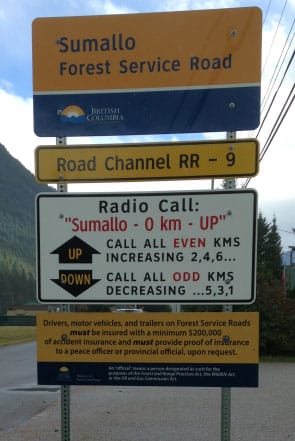
RESOURCE ROAD RADIO
In 2015, BC started rolling out the Resource Road Radio Program province-wide. Previously, many active FSRs used the operating company’s own leased frequencies, leaving other road users unsure in advance of what channels they would need to monitor for traffic. The RR project created a common set of 35 road channels for use on public FSRs throughout the province, along with standardized protocol and signage. This allows FSR users to have their radios pre-loaded with all 35 RR channels and 14 “loading” channels, and easily switch to the appropriate one when entering an FSR.
It’s important to note that it is only legal to transmit on these channels using a certified and licensed land mobile (“commercial” or “business”) radio. The license is available by submitting an application and license fee ($42 annually, prorated) to ISED, and only a qualified person or radio shop is allowed to program them. Most shops can assist you in submitting the license application, and will program the assigned channels for minimal cost or for free.
Outside of a land mobile radio, it is also only legal to program the channels for monitoring in a radio that is incapable of transmitting on them – specifically, a “true” ham radio that is restricted to transmitting within the ham bands. It is not legal to enter these frequencies into “unlocked” radios such as Baofengs and other Chinese radios.
Yes, we understand it’s “a safety thing”. That doesn’t “make it okay” to use them illegally, when nobody is restricted from BEING legal: anyone can pick up a land mobile radio, get the license, and be golden (an older Icom can be had for $150 or less). Or pick up a scanner and listen to anything you want.
One should also remember that these are business-related frequencies and not to be used for general chit-chat between groups; they’re there to keep other road users apprised of traffic location and conditions, nothing more.
- More info on the program is available at: https://www2.gov.bc.ca/gov/content/industry/natural-resource-use/resource-roads/radio-communications
- Channel Assignment Maps: https://www2.gov.bc.ca/gov/content/industry/natural-resource-use/resource-roads/radio-communications/channel-maps
- Signage Standards: https://www2.gov.bc.ca/gov/content/industry/natural-resource-use/resource-roads/engineering-standards-guidelines/forest-service-road-signs
- Best Practices (PDF): https://www2.gov.bc.ca/assets/gov/farming-natural-resources-and-industry/natural-resource-use/resource-roads/bmps_for_radio_use_installation_maintenance_final.pdf
- Videos from the BC Forest Safety Council and Overland Training Canada:
AMATEUR RADIO
Amateur or “ham” radio is the most popular radio service for backcountry communications in BC, due it its potential range, higher power than license-exempt devices, variety of features such as APRS, and the ability to use repeaters.
As with other radio services, while anyone can listen freely, one must have the proper qualification to transmit on ham radio (commonly called a “ham license,” although it really isn’t). Basic ham qualification can be obtained by passing a course put on by a local radio club, but all you really need to do is pass the exam, and your certificate and call sign are then good for life. You can study online at sites like hamstudy.com, or by working through practice exams on ISED’s website. A list of examiners can be found there as well, and while they’re allowed to charge a small fee to cover expenses, most will administer the exam for free. The BC Ham Radio group on Facebook also has links to other resources for self-study, announcements of clubs that are running online courses, and examiners that will conduct the test online for free.
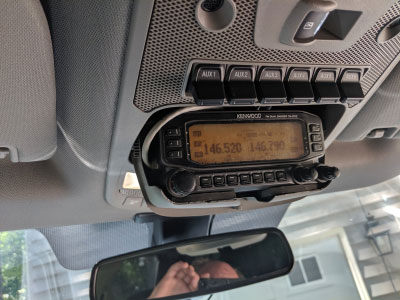
While it’s commonly referred to as “VHF”, there are actually ranges of frequencies set aside for hams in nearly every band. In the VHF (Very High Frequency, 30-300MHz) band, hams are allocated 50-54MHz (6m wavelength), 144-148MHz (2m), and 222-225MHz (1.25m). Other common frequency bands for hams to use are 28-29.7MHz (10m HF, or High Frequency) and 420-450MHz (70cm UHF, or Ultra High Frequency). Your basic Canadian ham qualification allows you to use these and others.
The ability to use repeaters to extend your contact range is one of the primary benefits of ham radio over other services. Some can link world-wide via Internet connections, others allow you to place phone calls. We recommend downloading the RepeaterBook app to your phone or tablet; it works offline and can use the built-in GPS to find your location and show you the nearest repeaters to you.
Off-roaders around North America commonly use 146.460MHz as their primary contact frequency. 146.520MHz is the designated “national calling frequency” in North America and the best option to make initial contact with someone else. It’s good etiquette to move to another frequency for chit-chat once contact has been made, but you want to familiarize yourself with which frequencies are designated for other uses (repeaters, APRS, CW, etc.)
It’s important to note that a ham license does not allow you to use land mobile frequencies such as the RR (Resource Road) channels; transmitting on those requires the relevant license from ISED (which can usually be obtained through a radio shop that sells and programs land mobile radios). It’s only legal to access those channels on a licensed land mobile (“commercial”) radio, or a radio that is incapable of transmitting on them (ie. no Baofengs or “modded” ham radios).
Useful links:
- Everything about Amateur Radio rules and regulations: https://www.ic.gc.ca/eic/site/smt-gst.nsf/eng/h_sf01709.html
- RBR-4 — Standards for the Operation of Radio Stations in the Amateur Radio Service: https://www.ic.gc.ca/eic/site/smt-gst.nsf/eng/sf10650.html
- Practice Exam Generator: https://www.ic.gc.ca/eic/site/025.nsf/eng/h_00040.html
- Online course and study guide: http://www.hamstudy.com
- BC Ham Radio group on Facebook: https://www.facebook.com/groups/bchamradio
- Radio Amateurs Canada: https://wp.rac.ca/
LICENSE-EXEMPT DEVICES
In general, ALL radio transmitters require a license of one kind or another for legal operation. The exceptions are known as “license-exempt devices”, transmitters that are limited in output power, signal type, and locked to frequencies specific to their purpose. These include things like cordless phones, garage door openers, RC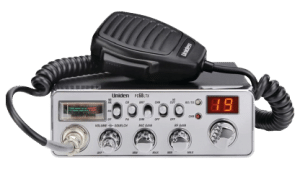
Off-the-shelf radios like CBs and FRS/GMRS (the Cobra, Motorola, Uniden, etc. “walkie talkies” you can find almost anywhere) also fall under the “license-exempt” category. They all have a few things in common: low power, preset channels, and fairly limited range. You can also buy any of them, slap them in your rig, and start yapping.
CB (Citizen’s Band) has one advantage in that vehicle-mounted models can use an external antenna for better range. The lower-frequency AM signal carries well at night and under the right conditions, you can use atmospheric “skip” to talk to people hundreds or thousands of miles away. CB isn’t as popular in hilly areas like the BC South Coast, where range is limited by terrain, but it’s still widely used in other areas where flatter land allows the signal to travel. Used radio/antenna packages can be had fairly cheap on eBay and Craigslist. Look for a model with SSB (Single Sideband) if you really want to get some range out of your comms.
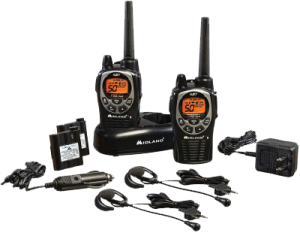
Note: GMRS in the US is a whole different beast, with higher-powered mobile radios, repeaters, and license requirements. These are not legal for use in Canada. Only radios that comply with Radio Standards Specification RSS-210 for License-Exempt Devices are allowed.
SATELLITE COMMUNICATIONS
Satellite communication could have a page all to itself, but for our purposes, we’ll try to summarize the different options briefly.
Satellite phones and internet hotspots are cool but very expensive, both in terms of hardware and for monthly access plans (other than single-use beacons, you’re not going to find anything that DOESN’T require a recurring plan), so we’ll leave that out for now.
Personal Locator Beacons are single-use devices with no subscription fee; you buy one, register it, and then just hit the SOS button if you’re ever in trouble. Not a bad idea to carry one in the bush, but not the most flexible option.
Many people now choose to carry satellite messaging devices. The most well-known names in this field are InReach and Spot, along with other relative newcomers such as ZOLEO and BivvyStick. Some models allow you to send messages and receive messages directly on the device; others require a smartphone app for anything beyond SOS and “check-in” messages. Some are built into GPS navigation devices with a map screen, while others are strictly for two-way messaging.
A relative newcomer to this arena is the Apple iPhone 14, which now includes satellite SOS signalling. It’s important to note that this occupies a space between PLBs and traditional satellite messengers: it does allow two-way text communications, but only with emergency services.
People like to praise ham radio for backcountry “emergency” use because of the ability to use repeaters to extend your range, but there are lots of areas of BC that are out of range of those repeaters, and even if you can hit one, it still relies on someone listening at the other end. Satellite communicators are the ultimate in backcountry safety, allowing you to send a message or summon help at the push of a button from almost anywhere in the world.
BACKCOUNTRY RADIO: THE BEST OF BOTH WORLDS
To date, the decision of which type of VHF radio to get has been a toss-up: for industrial communications, you need a radio that carries the Resource Road channels. If you only want to receive, ham radio will suffice, as most models can receive well outside the ham band. But if you want to talk to the big rigs – call your KMs, for example – you need a land mobile radio (also called a “commercial” radio) and the proper license to go with it.
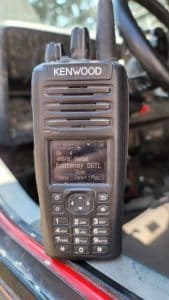
Some wheelers have long argued for one radio that could do both… and now we can offer that!
With a LOT of help from our Corporate Sustaining Member, Vernon Communications Ltd, we have applied for, and received, our own 4WDABC licensed frequency that is now a part of Appendix B1 of the ISED spectrum: in short, if you license your land mobile radio for LADD channels, you now get the 4WDABC channel for convenient backroads communications in your groups as well.
This greatly simplifies all-in-one backcountry communications for off-roaders province wide! One radio, one license, no course or test required. It also moves regular chatter off RR channels into an area where you can talk within your group without causing problems for industrial users.
Details on channel programming will be provided via Letter of Authorization (LOA) to 4WDABC members and others who request it, which you can then include with your license application to ISED for Appendix RR (Reasource Roads) and B1 (LADD).
To request your Letter of Authorization, please complete the form at https://bit.ly/4wdabcradiochannels
ISED has authorized the use of “light-mobile licensing” for RR and 4WDABC channel use. This includes a simplified online form that makes it easier both for users to fill out, and for ISED to process. Details on using this method are included with your LOA for the 4WDABC channel.
Buying a Used Radio
It’s true, a new land mobile radio can be expensive to get into – hey, you get what you pay for! So what can you do to save some coin, short of going with cheap craptastic grey-market handhelds that aren’t legal for RR/4WDABC channel use?
Facebook Marketplace, buy & sell groups, Craigslist, Kijiji, eBay, etc. are a good place to start… but how to make sure you get what you need?
If you’re a ham, you probably already know what to look for, and you can use just about anything available, so we’ll leave that out of the equation for now, and assume you’re just looking for a land mobile unit.
First up: if it’s listed as an amateur or ham radio, it’s not what you want. If it has buttons on the face or microphone for punching in your frequency, it’s the wrong type.
If it has a numbered channel display, it’s probably the wrong type. A handheld with channels 1-14 is likely FRS (Family Radio Service); with channels 1-22 or so, GMRS (General Mobile Radio Service). A mounted unit with channels 1-60 or higher is going to be marine VHF.
A land mobile may also be listed as a commercial, business, or simply two-way radio. Handhelds are just as likely to have no display at all, just buttons or a knob to select a channel. A mobile unit will generally have no numeric buttons for entering a frequency, maybe just some presets and a few control buttons on the faceplate.
Ask the seller for a model number, then look that up on the manufacturer’s website – see what kind of radio they list it as. In Canada, land mobile radios are certified under regulation RSS-119, and the manufacturer’s description may reflect that. In the US, the FCC certifies them under Part 90 – most radios of this type will say if they’re Part 90 compliant.
If you’re looking at a mobile unit, you also need an antenna: make sure you get one designed for 2m use. A CB antenna is not suitable for this purpose. Make sure it’s properly installed, tested, and tuned to get maximum performance.
If all else fails, feel free to drop an email to communications@4wdabc.ca with the radio model number or a link to the ad, and we’ll let you know if it fits the bill!
Handheld vs. Mobile
So you’ve decided on the type of radio you need. You’ve decided on used vs. new. Now you need to decide on the form factor.
Mobile (vehicle-mounted) radios are typically rated for 50-60W of output power, sometimes more. Handhelds (walkie-talkie style) are generally limited to 5W (sometimes 8W, if the marketing hype is to be believed). This gives mobile a decided advantage in transmit range.
However, receive range is not affected by the radio’s power output. The single biggest factor here is the antenna: a large external antenna, properly grounded to the vehicle body, will give you far better reception than a small “rubber duckie” antenna that’s being used inside a large metal box. An external antenna connected to a handheld should, all else being equal, give a handheld the same kind of reception as a mobile radio.
An external antenna will also potentially give your handheld far better transmit range than its bundled antenna, again primarily by virtue of being outside of that metal box that is your vehicle cab, and by having a good ground plane (said metal box). And again, you should, in theory, have the same range as a mobile radio on its lowest power setting.
The ability to take the radio with you for security is a plus with handhelds, but mobile radios usually have a quick-disconnect on the power wires and are attached their bracket with thumbscrews making them easy to remove and take in the house.
LMR Shopping Tips
When shopping for a land mobile radio, there area a few features in particular you should look for, including:
Alphanumeric display. Not just digits that show a channel number, but a display that will show you the channel name. A radio with no display will generally “speak” the channel number, but then you need to remember which channel is which memory location.
Memory locations. There are 35 RR channels, 14 LD (loading) channels, four LADD channels, and nine 4WDABC channels, so at a bare minimum you’ll be needing 62 memory slots to program these. If you’re a ham and want to program some common ham frequencies and repeaters, you’ll need more… perhaps many more. Radios tend to come with memory locations in counts of 4, 8, 16, 32, 64, 128, 512, or higher multiples. Make sure the radio you choose has enough. Land mobile radios typically support “banks” or “zones” that will let you better organize your programming.
